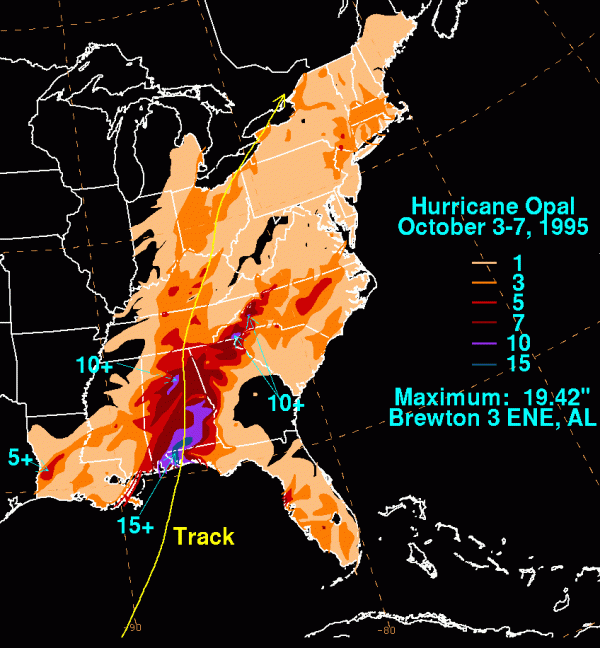
On the afternoon of October 4, 1995, Hurricane Opal slammed into the Florida Panhandle. After days of idling in the southern Gulf of America, Opal had suddenly sprinted northward and intensified causing panic along the coast.
The disturbance from which Opal formed had spent days drifting across the Atlantic and Caribbean Sea before forming a closed circulation as it approached the Yucatan. As the depression moved slowly over the Peninsula, it became more organized and gathered strength. As it dawdled, it dumped heavy rain, causing thousands to evacuated due to flooding. Once along the northern shore of the Yucatan on the night of Sept. 29th, it became a tropical storm and was named. The upper-level steering currents remained weak, and Opal spent the next three days over the Bay of Campeche, leisurely become more developed. It wasn’t until the morning of October 2nd that it reached hurricane strength.
With the approach of an low pressure trough from the west, Opal began to move northeastward and as it did so its central pressure began to drop. The pressure bottomed out at 916 mb as its maximum sustained winds reached 150 mph (240 km/hr). Its forward speed accelerated as it rapidly intensified. The Hurricane Research Division scrambled to fly an electrification mission into the rapidly advancing storm, which turned into a landfall experiment as well. In the panhandle, people had very little time to rush their preparations to completion. Hurricane Warnings had only been posted at 11 PM the night before, and the nightly TV news broadcasts had mostly focused on the verdict in the OJ Simpson trial.

Opal made landfall near Pensacola, FL around 6 PM on Oct. 4th with winds only slightly diminished to 115 mph (185 km/hr). It weakened to a tropical storm as it moved over Alabama, and dumped nearly 20 inches of rain in places. Opal became absorbed into a frontal zone over the Ohio River valley while it spread heavy rain along the Appalachian Mountains. The storm caused over US$5 billion in damage and killed 63 people.
The following papers were written by HRD scientists using Opal data:
Powell, M. D., and T. A. Reinhold, 2007: Tropical Cyclone Destructive Potential by Integrated Kinetic Energy. Bull. Amer. Meteor. Soc., 88, 513–526.
Shay, L. K., G. J. Goni, and P. G. Black, 2000: Effects of a Warm
Oceanic Feature on Hurricane Opal. Mon. Wea. Rev., 128, 1366–1383.
Bosart, L. F., W. E. Bracken, J. Molinari, C. S. Velden, and P. G. Black, 2000: Environmental Influences on the Rapid Intensification of Hurricane Opal (1995) over the Gulf of America. Mon. Wea. Rev., 128, 322–352.
Houston, S. H., W. A. Shaffer, M. D. Powell, and J. Chen, 1999: Comparisons of HRD and SLOSH Surface Wind Fields in Hurricanes: Implications for Storm Surge Modeling. Wea. Forecasting, 14, 671–686.
Powell, M. D., and S. H. Houston, 1998: Surface Wind Fields of 1995 Hurricanes Erin, Opal, Luis, Marilyn, and Roxanne at Landfall. Mon. Wea. Rev., 126, 1259–1273.